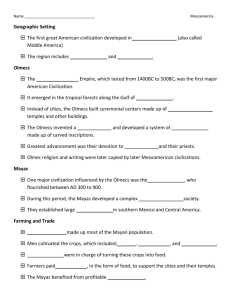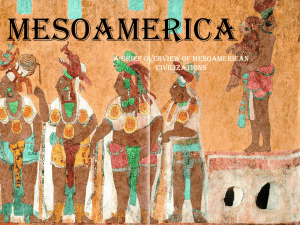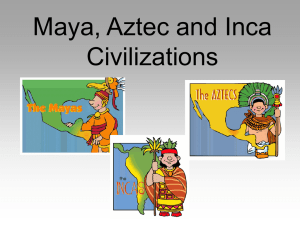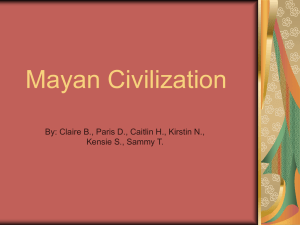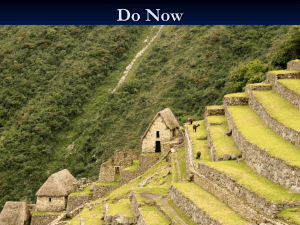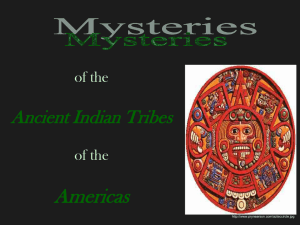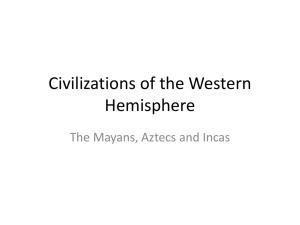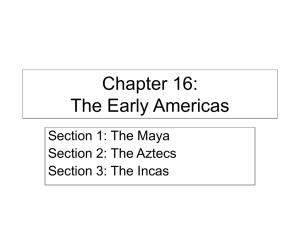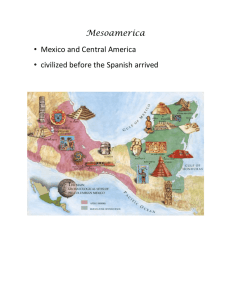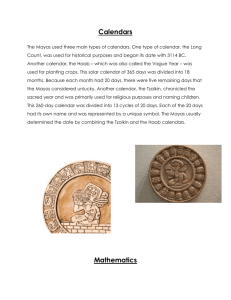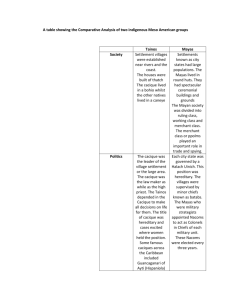Achievements of the Maya
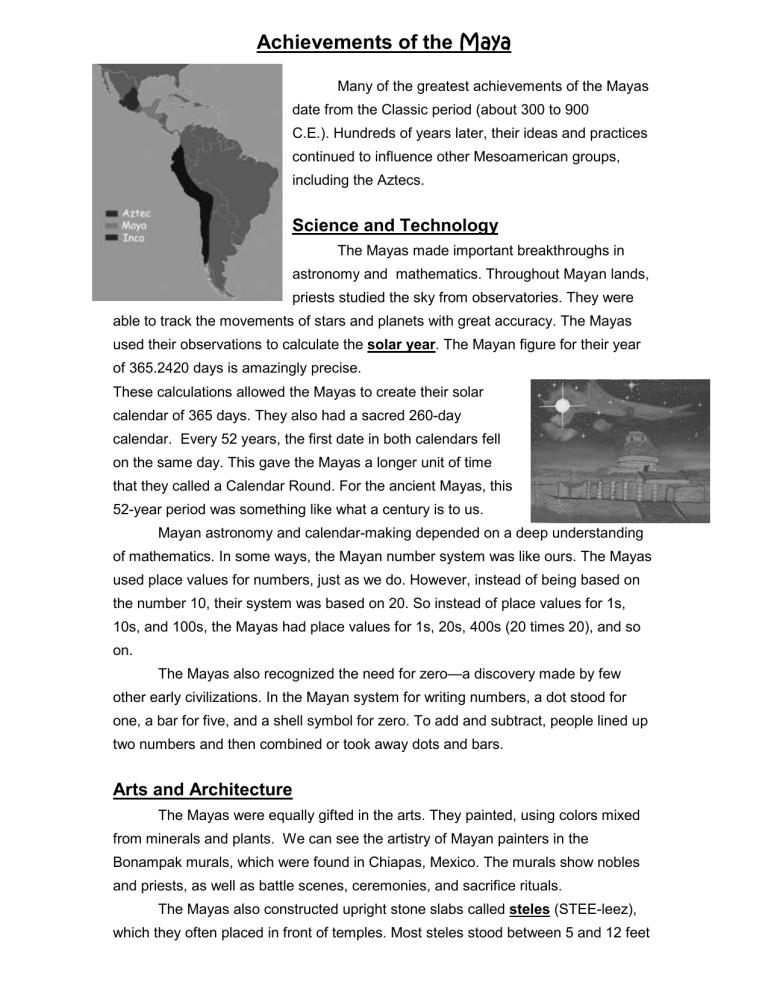
Achievements of the
Maya
Many of the greatest achievements of the Mayas date from the Classic period (about 300 to 900
C.E.). Hundreds of years later, their ideas and practices continued to influence other Mesoamerican groups, including the Aztecs.
Science and Technology
The Mayas made important breakthroughs in astronomy and mathematics. Throughout Mayan lands, priests studied the sky from observatories. They were able to track the movements of stars and planets with great accuracy. The Mayas used their observations to calculate the solar year . The Mayan figure for their year of 365.2420 days is amazingly precise.
These calculations allowed the Mayas to create their solar calendar of 365 days. They also had a sacred 260-day calendar. Every 52 years, the first date in both calendars fell on the same day. This gave the Mayas a longer unit of time that they called a Calendar Round. For the ancient Mayas, this
52-year period was something like what a century is to us.
Mayan astronomy and calendar-making depended on a deep understanding of mathematics. In some ways, the Mayan number system was like ours. The Mayas used place values for numbers, just as we do. However, instead of being based on the number 10, their system was based on 20. So instead of place values for 1s,
10s, and 100s, the Mayas had place values for 1s, 20s, 400s (20 times 20), and so on.
The Mayas also recognized the need for zero
—a discovery made by few other early civilizations. In the Mayan system for writing numbers, a dot stood for one, a bar for five, and a shell symbol for zero. To add and subtract, people lined up two numbers and then combined or took away dots and bars.
Arts and Architecture
The Mayas were equally gifted in the arts. They painted, using colors mixed from minerals and plants. We can see the artistry of Mayan painters in the
Bonampak murals, which were found in Chiapas, Mexico. The murals show nobles and priests, as well as battle scenes, ceremonies, and sacrifice rituals.
The Mayas also constructed upright stone slabs called steles (STEE-leez), which they often placed in front of temples. Most steles stood between 5 and 12 feet
tall, although some rose as high as 30 feet. Steles usually had three-dimensional carvings of gods and rulers. Sometimes, the Mayas inscribed them with dates and hieroglyphics in honor of significant events.
Another important art was weaving. We know from steles and paintings that the Mayas wove colorful fabric in complex patterns. Women made embroidered tunics called huipiles and fashioned lengths of cloth for trade. Mayan women still use similar techniques today. They still make their huipiles in traditional designs. People from different towns can be distinguished by the colors and patterns of their garments.
In architecture, the Mayas built temple-pyramids from hand-cut limestone bricks. An unusual feature of Mayan buildings was a type of arch called a corbel vault. Builders stacked stones so that they gradually angled in toward each other to form a triangular archway. At the top of the arch, where the stones almost touched, one stone joined the two sides. The archway always had nine stone layers, representing the nine layers of the underworld (the place where souls were thought to go after death).
Language and Writing
The Mayas developed the most complex system of writing in the ancient Americas. They used hieroglyphics, or picture symbols, to represent sounds, words, and ideas. Hieroglyphic inscriptions have been found on stoneware and other artifacts dating from possibly as early as 300 B.C.E.
Over time, the Mayas created hundreds of glyphs . Eventually, scribes could write down anything in the spoken language. They often wrote about rulers, history, myths and gods, and astronomy.
Not all Mayan groups shared the same language. Instead, they spoke related dialects . Today, about four million Mesoamericans still speak one of thirty or so Mayan dialects.
Achievements of the
Aztec
Science and Technology
One of the Aztecs’ most remarkable technological achievements was the construction of their island city, Tenochtitlán. The Aztecs enlarged the area of the city by creating artificial islands called chinampas . Today, flower farmers in
Xochimilco, near Mexico City, still use chinampas. Tourists enjoy taking boat trips to see these “floating gardens.”
Just as impressive as the chinampas were the three causeways that connected Tenochtitlán to the mainland. The causeways were often crowded with people traveling in and out of the capital. During the rainy
To manage time, the Aztecs adapted the Mayan solar and sacred calendars. The 365-day solar calendar season, when the waters of the lake rose, the causeways also served as dikes. was especially useful for farming, since it tracked the seasons. Priests used the sacred 260-day calendar to predict events and to determine “lucky” days for such things as planting crops and going to war.
One of the most famous Aztec artifacts is a calendar called the Sun Stone. Dedicated to the god of the sun, this beautifully carved stone is nearly twelve feet wide and weighs almost twenty-five tons. The center shows the face of the sun god. Today, the Sun Stone is a well-known symbol of Mexico.
Arts and Architecture
The Aztecs practiced a number of arts, including poetry, music, dance, and sculpture. Poets wrote verses to sing the praises of the gods, to tell stories, and to celebrate the natural world. Poetry was highly valued. Aztec poets sung their poems or recited them to music. Sometimes, actors performed them, creating a dramatic show with dialogue and costumes.
Music and dance were important features of Aztec ceremonies and holidays. People dressed up for these special occasions. Women wore beautiful blouses over their skirts. Men painted their faces, greased their hair, and wore feathered headdresses. The dancers formed large circles and moved to the beat of drums and the sound of rattle bells. The dances had religious meaning, and the dancers had to perform every step correctly. Sometimes, thousands of people danced at one time. Even the emperor occasionally joined in.
The Aztecs were also gifted painters and sculptors. Painters used brilliant colors to create scenes showing gods and religious ceremonies. Sculptors fashioned stone statues and relief sculptures on temple walls. They also carved small, lifelike figures of people and animals from rock and semiprecious stones, such as jade. In technical craft and beauty, their work surpassed that of earlier Mesoamerican cultures.
In architecture, the Aztecs are best remembered today for their massive stone temples. The Aztecs were unique in building double stairways, like those of the Great Temple in Tenochtitlán. The staircases led to two temples, one for the sun god and one for the god of rain. Smaller pyramids nearby had their own temples, where sacrificial fires burned before huge statues of the gods.
Language and Writing
Spoken language was raised to an art in Aztec society. Almost any occasion called for dramatic and often flowery speeches. The rich vocabulary of the Aztec language, Nahuatl, allowed speakers to create new words and describe abstract concepts.
The Aztec system of writing used both glyphs and pictographs . A pictograph is a drawing that depicts a word, phrase, or name, rather than symbolizes it. For example, the Aztec pictograph for war was a symbol of a shield and a club. The Aztecs did not have enough pictographs and glyphs to express everything that could be spoken in their language. Instead, scribes used writing to list data or to outline events. Priests used these writings to spark their memories when relating stories from the past.
Achievements of the Inca
Maintaining tight control over such a huge area was one of their most impressive accomplishments.
Science and Technology
The Incas’ greatest technological skill was engineering. The best example is their amazing system of roads.
The Incas built roads across the length and width of their empire. To create routes through steep mountain ranges, they carved staircases and gouged tunnels out of rock. They also built suspension bridges over rivers. Thick rope cables were anchored at stone towers on either side of the river. Two cables served as rails, while three others held a walkway.
In agriculture, the Incas showed their technological skill by vastly enlarging the system of terraces already in use by earlier Andean farmers. The Incas anchored their step-like terraces with stones and improved the drainage systems in the fields. On some terraces, they planted different crops at elevations where the plants would grow best.
To irrigate the crops, the Incas built canals that brought water to the top of a hillside of terraces. From there, the water ran down, level by level. People in South America still grow crops on
Incan terraces.
The Incas also made remarkable advances in medicine. Incan priests, who were in charge of healing, practiced a type of surgery called trephination . Usually, the patient was an injured warrior. Priests cut into the patient’s skull to remove bone fragments that were pressing against the brain. As drastic as this sounds, many people survived the operation and recovered full health.
Arts and Architecture
Making textiles for clothing was one of the most important Incan arts. The quality and design of a person’s clothes were a sign of status. The delicate cloth worn by Incan nobles often featured bright colors and bold geometric patterns. Incan women also made feather tunics, or long shirts, weaving feathers from jungle birds right into the cloth.
Fashioning objects out of gold was another important art. The Incas prized gold, which they called the “sweat of the sun.” Gold covered almost every inch inside the Temple of the Sun in the Incan capital city of Cuzco. Incan goldsmiths also fashioned masks, sculptures, knives, and jewelry.
Music was a major part of Incan life. The Incas played flutes, seashell horns, rattles, drums, and panpipes. Scholars believe that the modern music of the Andes region preserves elements of Incan music.
In architecture, the Incas are known for their huge, durable stone buildings. The massive stones of Incan structures fit together so tightly that a knife blade could not be slipped between them. Incan buildings were sturdy, too —many remain standing today.
Language and Writing
The Incas made their language, Quechua
(KECH-wah), the official language of the empire. As a result, Quechua spread far and wide. About ten million people in South America still speak it.
The Incas did not have a written language. Instead, they developed an ingenious substitute: the knotted sets of strings called quipus . The Incas used quipus as memory aids when sending messages and recording information.
